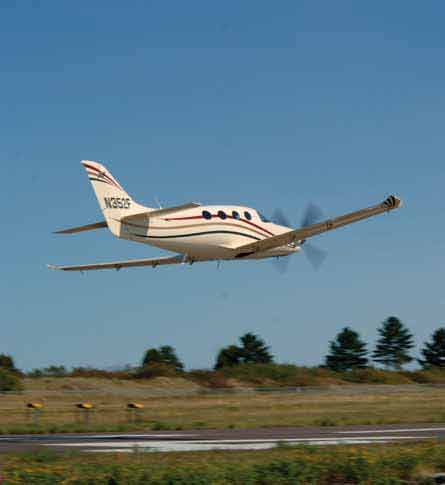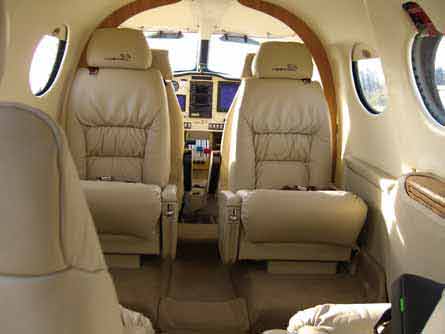The history of general aviation is littered with grand ambitions, desperate deals and squandered millions. For Farnborough Aircraft (FACL), the battle to become the first UK company to certificate an all-new passenger aircraft in more than three decades has been expensive and frustrating, involving bitter legal and financial disputes firstly with the original developer of the aircraft and then with its former US partner, with which it built the prototype.
After more than six years of being kept alive to the tune of more than £10 million ($19 million) by a private investor who made his fortune in contact lenses, FACL is the latest aviation company to turn to the Middle East for salvation. The company is working to secure a deal with local financial institutions to begin manufacturing the JP100 Kestrel in a joint venture with Abu Dhabi maintenance house Gamco, which would be involved in certificating the six-seat single-engine turboprop.
|
|---|
Composite airframe results in blended shapes and smooth surfaces |
The Kestrel, previously the F1, was begun in the late 1990s by former land-speed record-holder Richard Noble as an air-taxi project using funds from hundreds of small investors raised through an internet marketing campaign. With a small team of engineers, many of them involved in his Thrust SSC supersonic car, Noble set up a venture called FarnboroughAircraft.com, but got only part-way through design.
When money to pay wages began to run out in 2001, Geoffrey Galley stepped in. An entrepreneur with a record of bailing out risky speculative ventures, he offered an interim £1.25 million if Noble could match it. But Noble continued to struggle and a year later the company was wound up with intellectual property rights to the aircraft passing to Galley and a new business called Farnborough Aircraft.
Surefire design
The company's problem was that, although it believed it had a surefire design for a high-performance and economical business aircraft, it lacked the infrastructure to build a prototype, let alone the funds take it to certification and production. The solution: a design, development, construction and certification agreement with Aircraft Investor Resources (AIR) of Bend, Oregon to develop the Kestrel jointly with the US company's kit-built Epic LT.
But the relationship soured, and in 2005 FACL took AIR to court to force an injunction on its former partner to release the partly built prototype. Although FACL director Richard Blain is reluctant to say why the companies fell out, court papers show messy claims and counter-claims over who owned design rights, which ended with FACL taking legal possession of the first aircraft and completing it in a rented hangar in Bend, where it flew for the first time on 29 July last year before being ferried to the UK to have its interior fitted.
|
|---|
The prototype does not have the instrumentation planned for the production version |
After a second ferry flight in late November, which included stops in Switzerland, Italy, Crete, Egypt and Saudi Arabia, the Kestrel prototype has spent the last few weeks at Gamco in Abu Dhabi and has completed over 100h in the air. Blain is anxious that prospective investors, industrial partners and customers sample the Pratt & Whitney Canada PT6A-powered aircraft. "We are keen to get people up in it. When we have, they have come back with an incredible adrenaline rush."
Flight International had an opportunity to assess the aircraft, which is a "proof-of-concept" or "close to full-size" prototype being used to define the production version. The Kestrel is at an early stage of development, having flown only 80h at the time of our flight, and the never-exceed speed was limited at 189kt indicated (350km/h) and the handling assessment performed below 10,000ft (3,000m).
Tentatively priced at $2.5 million, the Kestrel is designed to compete with very light jets such as the Cessna Citation Mustang and Eclipse 500 and "very fast turboprops" such as the EADS Socata TBM 850. FACL chose a single-turboprop design for its longer high-speed cruise range, lower fuel consumption and ability to operate from shorter runways and austere airfields.
The airframe is almost completely carbonfibre, endowing it with blended shapes, smooth surface finish, light weight and structural crash resistance. The engine fitted is a 1,200shp (895kW) PT6A-67A with a four-blade Hartzell propeller with reverse pitch. A 1,000shp -67B engine is planned for the production version.
The cabin has a club four layout, with the passenger seats facing each other. Entry is via a drop-down door with integral steps behind the rear seat pair and this area will feature an enclosed toilet in the production aircraft. FACL believes this will add to the suitability and practicality of the Kestrel, given its estimated NBAA IFR range with four occupants of 2,640km (1,430nm). The aircraft is pressurised for a maximum cruise altitude of 31,000ft.
High-speed cruise is planned as 352kt at 25,000ft or 346kt at 30,000ft, which would make it faster than the Mustang (340kt), but slower than the Eclipse 500 (370kt). All leading edges are now booted for ice protection, but FACL plans to fit a more advanced system, possibly electrical discharge, to improve wing aerodynamics.
The main gear is a trailing-link design and, combined with an inertial separator in the intake, should allow the Kestrel to operate from semi-prepared landing strips.
For our evaluation from Biggin Hill, take-off weight with two pilots was 3,020kg (6,650lb) and the centre of gravity in roughly mid-position, but the prototype was carrying all its test equipment. The production version will be lighter, says FACL. Safety pilot for the flight was project experimental test pilot Graham Archer.
Cockpit access
While adequate in height, the entry door could be made wider as passengers will have to bend and turn left into the cabin. Cockpit access was adequate, although the seat armrests narrow the space for entry. FACL would find it advantageous to offer a "pilot's door" on the production version, as is available on the TBM 850.
Pilot seats were comfortable, with a good range of adjustments, but the rudder pedals seemed a little too upright. Conventional yoke controls operating on a shaft into the front console did not foul the pilot's legs or obscure critical instruments. Controls are conventional and cable-operated in all axes. Breakout force was a little high (about 1kg), but the overall friction in pitch and roll was too high and FACL aims to rectify this by changing the control linkages to rods.
|
|---|
Access to cabin and cockpit is from the rear entry door |
Field of view in ground attitude was excellent even over the long nose and especially to the side and rear, where carbonfibre construction allows a windscreen without side pillars. But eyebrow windows would allow a pilot in the left-hand seat to "look into" a right-hand turn. Field of view was only an issue in the flapless approach, where the long nose and high nose attitude made it difficult to maintain visual runway contact at all times.
Instrumentation was unique to the prototype, and not that planned for production. Engine controls consisted of three levers - torque (black), propeller (blue) and condition (red - essentially combined high- and low-pressure fuel cocks). Fitting digital engine control and de-rating the power for take-off and approach would help FACL market the Kestrel as having a "jet-like" single power-lever cockpit.
The prototype lacked nosewheel steering, and was manoeuvred on the ground using differential toe brakes. But the combination of odd rudder pedal angle and ineffective mainwheel brakes made for poor taxi/turn steering response. Archer says this will be fixed in the production version.
Savage acceleration
After simple line-up checks, the power lever was opened slowly so as not to exceed 100% torque, but even so the power bite and initial acceleration was quite savage and showed how much excess thrust the aircraft possessed. Yaw to the left during the take-off roll could be controlled with decisive right rudder-pedal input, but as turboprops need more trimming than jets, the aircraft would benefit from a well positioned and clearly defined trim display.
Rotate was at 75kt indicated, lift-off at 80kt and ground roll was about 500m. Gear retraction produced no trim change (although the main undercarriage doors were not fitted), but bringing the flaps up (at about 4º/s) produced a marked nose-down trim change with which the yoke-mounted electric trim had a problem coping. Increasing the electric trim rate would help, as would offering a manual trim wheel to take out "coarse" trim forces and then fine trim on electric. Flap position was fully variable, but FACL says the production version will have a gated lever.
Initial climb was at 115kt and 10-12º pitch attitude to 2,000ft for an initial cruise, with the torque reduced to about 35% to hold 170kt. On a further climb at 100% torque in clean configuration the aircraft achieved a sustained climb of 20º nose up, 140kt and a climb rate of 4,000ft/min (20.3m/s). Static longitudinal stability was strong with speed change, which required a lot of pitch trimming, and this, coupled with the control-run friction and the high force gradients around neutral in both pitch and roll, made the aircraft somewhat tiring to fly accurately and to make small corrections to the flight path.
It will be a priority to tackle this and a small directional "wander" in cruise by reducing breakout and friction, possibly increasing control power and perhaps installing an active yaw damper. Short-period reaction to a pitch-control input was about 1s and well damped, while the phugoid (long period) was about 25s - both acceptable.
Pulling into a wind-up turn to 2.5g at 160kt produced no signs of buffet or wing rock/drop. Dutch roll was easy to induce, but showed positive damping. Sustained roll rate at 140kt was acceptable at around 30º/s. No adverse yaw with aileron input was displayed, neutral spiral stability and up to 20º of sideslip could be generated and held against 20º of opposite bank, showing an ability to kick off drift in a crosswind.
Stalling with flaps at zero, mid (17º) and full (38º) produced stall speeds of 67kt, 57kt and 53kt, respectively. Natural stall buffet was recognisable, but weak, and the aircraft was prone to wing drop in either direction to angles up to about 60º of bank with increasing flap setting. This needs to be improved for certification.
Simulated go-arounds flown at medium level again showed power had to be applied with care. Any rapid advance of the lever produced a ferocious power bite as the engine accelerated through 50% torque, resulting in an enormous burst of acceleration, and it was easy to exceed the torque limit with what seemed only a small throttle angle movement.
Soft landing
Turns onto finals required a power setting of only 12-15% torque. The downwind leg, gear down, was flown at 110kt, slowing to 90kt with mid-flap for the finals turn and to 80kt for the approach with full flap and a VREF of 75kt. The flapless approach was flown at 95kt with a VREF of 90kt. Speed stability was good and touchdown points could be achieved accurately. The trailing-link gear mean touchdowns were soft and progressive. The short landing run showed the effectiveness of a turboprop's ability to dump lift and reverse thrust.
FACL has a "looks right" prototype that shows the potential to compete with modern six-seaters - if it can tame the power of the PT6A and match the aircraft's performance potential by installing the latest integrated displays.
Assuming financial backing, taking the aircraft to certification will take another 36 months, says Blain. Although it may be manufactured in Abu Dhabi, Blain is delighted the Kestrel could be the first new passenger aircraft design from a UK company to reach the market since the early 1970s. It could also be the last. The "massive" cost of certificating an aircraft in Europe, and the lack of an experimental category for more radical designs stacks the odds against innovators with limited resources, Blain says.
Source: Flight International


























